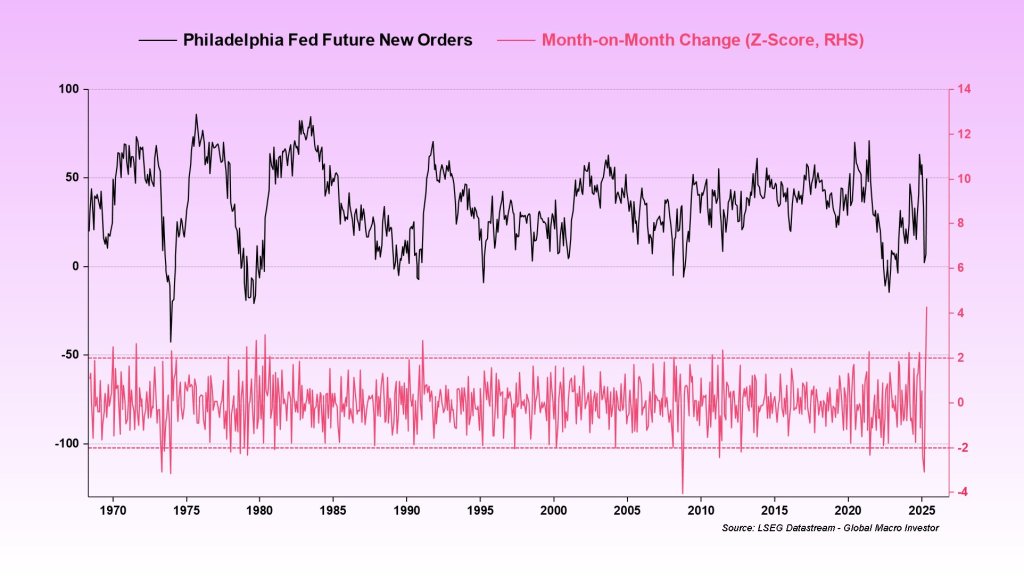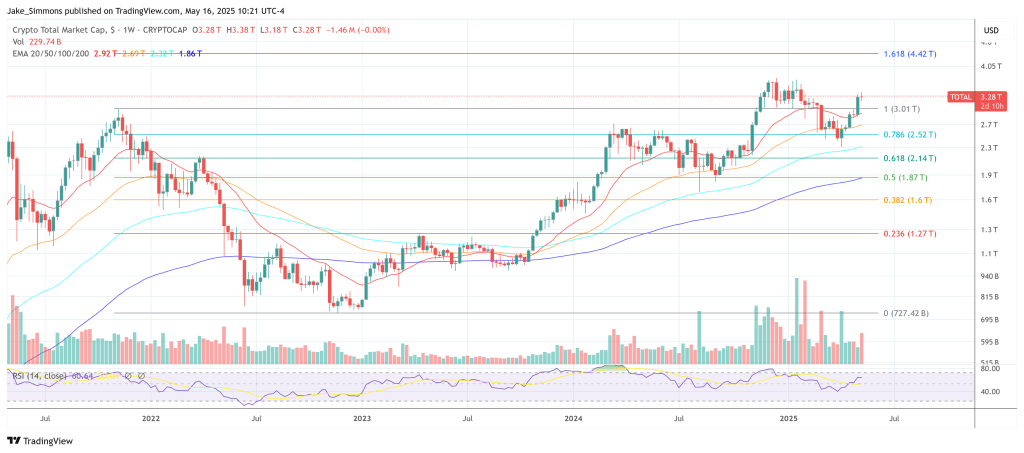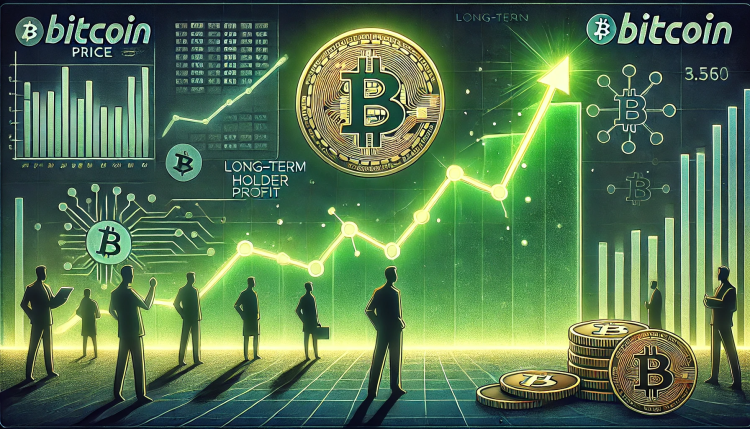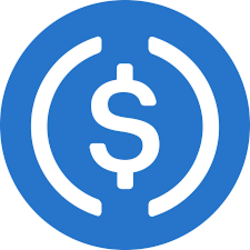An unprecedented surge in the Philadelphia Federal Reserve’s May Manufacturing Business Outlook Survey has jolted global risk markets and given crypto asset traders their clearest macro catalyst of the year. The Future New Orders diffusion index leapt by forty-plus points, a move that Julien Bittel, head of macro research at Global Macro Investor (GMI), called “literally” historic.
Crypto Bulls Can Rejoice
Bittel’s commentary on X framed the print with statistical precision: “Philly Fed data for May dropped yesterday – and the Future New Orders index just made history. Literally. … Expectations for new orders posted the largest monthly spike ever recorded – going all the way back to the index’s inception in May 1968. A staggering +4.3 standard deviation move. He underlined the shock with a comparison few macro watchers will forget: For perspective: that’s an even bigger move up than the downside collapse during the depths of the 2008 Global Financial Crisis (-4.1σ). Let that sink in…”

Bittel then set the surge in a broader narrative that has animated his research since late last year. “Q1 growth was weak. The reason is straightforward – financial conditions tightened sharply in Q4. The dollar ripped, bond yields surged… a classic tightening phase,” he wrote.
The proximate trigger, in his telling, was “businesses panic‑loading inventories ahead of Trump tariffs, and markets front‑running the inflation narrative.” Those dynamics, he argued, are a replay of Donald Trump’s first term: “We’ve highlighted repeatedly: this had all the hallmarks of Q4 2016 during Trump’s first term. Just like early 2017, that tightening spilled over into slower growth momentum in Q1.”
Where 2017 began with doubt and ended in a synchronous global boom, Bittel believes 2025 is rhyming. “Those Q1 headwinds have flipped into Q2 tailwinds,” he insisted. “Everything flows downstream from changes in financial conditions… Purchasing managers’ expectations are shifting – and shifts in thinking eventually translate into action. Sentiment shifts first. Action follows. It always does. Bullish.”
The crypto market responded muted. Bitcoin reclaimed the $104,000 level in early‑European trade, but lost it later on. Ether steadied near $2,600, and high‑beta layer‑one tokens such as Solana and Avalanche moved in tandem.
Giancarlo Cudrig, head of markets at Immutable, said the scale of the shock is less important than how under‑positioned investors are for an upside growth surprise. “An upside economic shock like this – +4.3σ on new orders – is rare. But the bigger story is market positioning. Asset prices are not prepared. The melt‑up is the asymmetric risk. Now it’s being repriced.”
Independent analyst Market Heretic struck a similar note on X: “When this dropped, markets didn’t even blink. Because the shift’s already in motion. This wasn’t news, it was confirmation. That’s the real tell, when markets shrug off a four‑sigma upside shock. It means the turn is already upon us – and it’s just getting started.”
For crypto investors, the implications are immediate. A softer dollar and retreating real‑yield expectations reduce the opportunity cost of holding non‑yielding assets, while the early phase of a reflationary turn historically favours high‑beta exposures. Bittel’s own playbook is unambiguous: “Sentiment shifts first. Action follows.” As long as that chain reaction continues, the crypto bulls appear to have both math and momentum on their side.
At press time, the total crypto market cap stood at $3.28 trillion.

An unprecedented surge in the Philadelphia Federal Reserve’s May Manufacturing Business Outlook Survey has jolted global risk markets and given crypto asset traders their clearest macro catalyst of the year. The Future New Orders diffusion index leapt by forty-plus points, a move that Julien Bittel, head of macro research at Global Macro Investor (GMI), called “literally” historic. Crypto Bulls Can Rejoice Bittel’s commentary on X framed the print with statistical precision: “Philly Fed data for May dropped yesterday – and the Future New Orders index just made history. Literally. … Expectations for new orders posted the largest monthly spike ever recorded – going all the way back to the index’s inception in May 1968. A staggering +4.3 standard deviation move. He underlined the shock with a comparison few macro watchers will forget: For perspective: that’s an even bigger move up than the downside collapse during the depths of the 2008 Global Financial Crisis (-4.1σ). Let that sink in…” Bittel then set the surge in a broader narrative that has animated his research since late last year. “Q1 growth was weak. The reason is straightforward – financial conditions tightened sharply in Q4. The dollar ripped, bond yields surged… a classic tightening phase,” he wrote. Related Reading: Analysis: Crypto Heats Up As $35 Billion Enters Market In Under A Month The proximate trigger, in his telling, was “businesses panic‑loading inventories ahead of Trump tariffs, and markets front‑running the inflation narrative.” Those dynamics, he argued, are a replay of Donald Trump’s first term: “We’ve highlighted repeatedly: this had all the hallmarks of Q4 2016 during Trump’s first term. Just like early 2017, that tightening spilled over into slower growth momentum in Q1.” Where 2017 began with doubt and ended in a synchronous global boom, Bittel believes 2025 is rhyming. “Those Q1 headwinds have flipped into Q2 tailwinds,” he insisted. “Everything flows downstream from changes in financial conditions… Purchasing managers’ expectations are shifting – and shifts in thinking eventually translate into action. Sentiment shifts first. Action follows. It always does. Bullish.” The crypto market responded muted. Bitcoin reclaimed the $104,000 level in early‑European trade, but lost it later on. Ether steadied near $2,600, and high‑beta layer‑one tokens such as Solana and Avalanche moved in tandem. Related Reading: Ethereum Gains Momentum Amid Flat Funding Rates – Is This A Healthy Uptrend? Giancarlo Cudrig, head of markets at Immutable, said the scale of the shock is less important than how under‑positioned investors are for an upside growth surprise. “An upside economic shock like this – +4.3σ on new orders – is rare. But the bigger story is market positioning. Asset prices are not prepared. The melt‑up is the asymmetric risk. Now it’s being repriced.” Independent analyst Market Heretic struck a similar note on X: “When this dropped, markets didn’t even blink. Because the shift’s already in motion. This wasn’t news, it was confirmation. That’s the real tell, when markets shrug off a four‑sigma upside shock. It means the turn is already upon us – and it’s just getting started.” For crypto investors, the implications are immediate. A softer dollar and retreating real‑yield expectations reduce the opportunity cost of holding non‑yielding assets, while the early phase of a reflationary turn historically favours high‑beta exposures. Bittel’s own playbook is unambiguous: “Sentiment shifts first. Action follows.” As long as that chain reaction continues, the crypto bulls appear to have both math and momentum on their side. At press time, the total crypto market cap stood at $3.28 trillion. Featured image created with DALL.E, chart from TradingView.com Cryptocurrency Market News, bitcoin, crypto, Crypto market news, crypto news, cryptocurrency, fed NewsBTC





















































































































